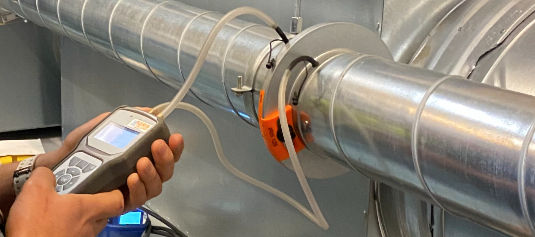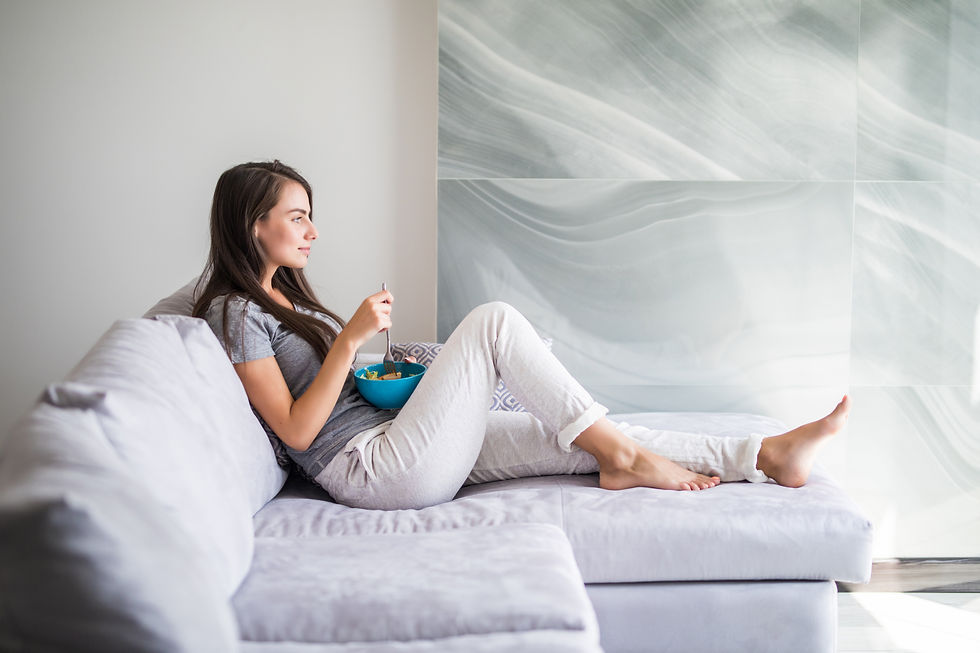What is negative and positive pressure, and how do they affect air ventilation?
- Mikael Denut

- 1.8.2024
- 6 min käytetty lukemiseen
Ventilation is a key factor in maintaining healthy and comfortable indoor air quality in a building. Its efficiency is significantly influenced by air pressure, which can be either negative or positive. This article explains what negative and positive pressure mean, how they affect ventilation, and why it is important to properly adjust the ventilation system.
What is air pressure, and how is it related to air ventilation?
Air pressure is the weight of the atmosphere exerted on a specific area, and it varies based on altitude, weather, and other factors. Inside a building, air pressure can be either negative (indoor air pressure is lower than outdoor air pressure) or positive (indoor air pressure is higher than outdoor air pressure). The purpose of air ventilation is to exchange indoor air with outdoor air, and differences in air pressure play a crucial role in this process.
Negative pressure occurs when the air pressure inside a building is lower than the outside air pressure, causing air to flow in from outside. This helps remove moisture and impurities, preventing moisture and mold problems. Positive pressure, on the other hand, occurs when the indoor air pressure is higher than the outdoor air pressure, causing air to flow out. This can push moisture into the building’s structures, leading to water damage and mold growth.
Managing air pressure differences is essential for achieving effective air ventilation. A slight negative pressure is recommended as it helps protect the building from moisture and mold issues, whereas positive pressure can exacerbate these problems. Therefore, proper adjustment of the air ventilation system and control of air pressure are crucial for maintaining good indoor air quality in the building.
Negative Pressure

Negative pressure occurs when more air is removed from a space or building than is brought in, causing air to flow inward from the outside. Excessive negative pressure is noticeable when opening a door or window becomes difficult and air rushes in with a hissing sound. This can result from insufficient incoming air or blocked air supply vents. Negative pressure can have harmful effects:
Moisture Accumulation in Structures: Excessive negative pressure can draw humid outdoor air through the building’s structures, potentially causing moisture and mold damage, although this is rare.
Worsening Indoor Air Quality: Negative pressure can pull air through gaps and insulation, bringing in impurities such as fiberglass dust.
Radon: Negative pressure can increase the amount of radon gas in indoor air, which is harmful to health.
Drafts: Negative pressure can draw in cold outdoor air, making the indoor environment drafty and uncomfortable.
Increased Heating Costs: Excessive negative pressure can cause heated air to escape, increasing heating expenses.
Positive Pressure

Positive pressure occurs when more air flows into an indoor space than is removed. This can result from a clogged exhaust air filter, a malfunctioning exhaust fan, or an improperly adjusted air ventilation system. Positive pressure often causes problems:
Moisture Accumulation in Structures: Positive pressure pushes air through the building’s structures, which can lead to moisture buildup and mold growth.
Worsening Indoor Air Quality: Positive pressure can exacerbate indoor air quality issues by causing moisture and impurities to accumulate in the structures.
Indoor Air Impurities: Positive pressure can prevent the ventilation system from functioning properly, leading to ineffective removal of impurities.
Decreased Comfort: Excessive positive pressure can cause drafts and discomfort as the air supply units push too much air into the space.
Increased Energy Consumption: Maintaining positive pressure increases energy consumption, as the ventilation system has to work harder.
What Should Be Aimed For?
Both excessive negative pressure and positive pressure can be harmful. In Finland, regulations have varied: in the 1970s, a 20% negative pressure was targeted, in the 1990s it was 10%, in the 2000s it was 5-10%, and since 2018 the recommendation has been 0% negative pressure, or balance. However, IVAeris Oy recommends a slight negative pressure of about 1-2%, as it is safer for the building structures, indoor air quality, and overall comfort compared to positive pressure.

The correct adjustment of the air ventilation system is crucial. A properly adjusted system significantly improves indoor air quality, prevents moisture and draft issues, and reduces energy consumption. Slight negative pressure has advantages, as it prevents the building from becoming positively pressurized when the exhaust air filter becomes dirty. Pressure-controlled ventilation is another option, but it can be a more expensive solution.
Why to Aim for a Slight Negative Pressure in Air Ventilation?

Although Finnish regulations recommend balanced ventilation, it is often practical to adjust the system to a slightly negative pressure, unless a pressure-controlled system is used. There are several reasons for this:
Dirty Filters: Over time, the filters in the ventilation system accumulate dirt and dust, reducing the efficiency of the exhaust air. A perfectly balanced system can become positively pressurized in just a few weeks as the filters get dirty.
Moisture Control: Slight negative pressure helps manage moisture in the building. Negative pressure draws air in from outside, preventing moisture from accumulating in the structures and minimizing the risk of mold problems.
Safety and Efficiency: Setting the ventilation system to be slightly negatively pressurized, around a couple of percent, ensures that the system operates efficiently and safely, preventing accidental positive pressure.
Where is Positive Pressure Utilized?
Positive pressure is particularly important in cleanrooms and hospital operating rooms, where maintaining sterility is crucial. Positive pressure prevents contaminants from entering the space by ensuring that air flows outward, blocking impurities from getting in.
Cleanrooms: Positive pressure is essential in cleanrooms used in semiconductor and microprocessor production, as well as in the aerospace and defense industries, where even the smallest contaminants can disrupt processes. In cleanrooms, air is continuously pumped in through HEPA filters and the ventilation system. If a door or window is opened, air flows out, ensuring that products and processes are protected from pollutants and impurities. A slight positive pressure also helps achieve cleanroom classifications and maintain a cleaner environment.
Hospital Operating Rooms: In operating rooms, positive pressure prevents outside air from entering, reducing the risk of infections. The air supplied to operating rooms is highly filtered and clean. Uncontrolled outside air could introduce contaminants and increase infection risks. Therefore, operating rooms are kept positively pressurized, while the surrounding areas are maintained with negative pressure to ensure that excess air flows out.

Residential Buildings: Positive pressure is utilized in residential buildings, such as when using a fireplace. During ignition, the “fireplace mode” on the ventilation system can be activated, reducing exhaust air and increasing supply air. This prevents smoke from entering the room when the fireplace is not yet drawing properly. The fireplace mode improves comfort and safety by preventing smoke from entering the living space.
Utilizing positive pressure in various settings ensures high indoor air quality and minimizes the risk of contamination.
Effects of Pressure Ratios on Energy Consumption
Pressure ratios have a significant impact on energy consumption in air ventilation systems. Excessive negative pressure can lead to increased energy consumption, as heated air escapes from the building and incoming cold air must be continuously reheated. Although heat recovery systems (HRVs) utilize the heat from exhaust air, excessive negative pressure significantly raises heating costs. Conversely, excessive supply air can reduce heating costs but may cause issues such as HRV freezing in extremely cold weather and moisture accumulation in structures. Adjusting to a balanced or slightly negative pressure helps reduce energy consumption and save costs in the long term.
Use of Pressure Ratios in Ventilation - Future Outlook
The optimal pressure ratio may vary with the use of the building. Sometimes negative pressure is necessary, while in other situations, positive pressure may be essential. In the future, smart systems could further improve living comfort. As technology advances, we can expect new innovations and solutions that make air ventilation more energy-efficient and ensure better indoor air quality. For example, intelligent air ventilation systems could automatically adjust pressures and airflow as needed, enhancing both energy efficiency and user comfort.

Negative and Positive Pressure - What is Important to Keep in Mind Now?
The goal of an air ventilation system is to maintain balanced ventilation within a building. However, in practice, it is recommended to adjust the system slightly towards negative pressure. This ensures better moisture control and reduces the risk of moisture and mold problems. It is crucial to regularly maintain and clean the ventilation system to prevent filters from becoming dirty and causing positive pressure.
IVAeris Oy offers expert services for the installation, maintenance, and adjustment of air ventilation systems, ensuring that you can enjoy healthy and comfortable indoor air. Proper adjustment and maintenance of the ventilation system not only improve indoor air quality and reduce moisture issues but also save energy and lower heating and cooling costs.
IVAeris Oy is a reliable partner for air ventilation installation and maintenance work. Our customers are more than just numbers to us; we provide personalized service and strive to improve indoor air quality in buildings. Do not hesitate to contact us if you have any questions about air ventilation. Together, we can create a human-centered experience without compromising on quality.

Take care of your air ventilation system and enjoy clean, healthy indoor air free from harmful impurities. If you suspect ventilation issues or care about healthy indoor air, contact IVAeris Oy today!
WE KNOW, WE CARE & WE GET IT DONE
IVAeris Oy
010 206 3000


